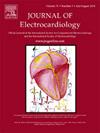心电图复极能否预测糖尿病发病率:社区动脉粥样硬化风险研究。
IF 1.3
4区 医学
Q3 CARDIAC & CARDIOVASCULAR SYSTEMS
引用次数: 0
摘要
背景:糖尿病以代谢失调和高心血管风险为特征。在糖尿病发病前,心脏变化标志物经常出现,但预测糖尿病的发生仍然具有挑战性。方法:该研究包括11,297名年龄在45-64岁之间的ARIC研究参与者,基线无糖尿病或心脏病,记录12导联心电图。采用Cox回归模型分析复极参数(QTc间隔、j点水平、T波振幅、T波/R波(T/R)比)与糖尿病风险的关系。相关性分析探讨了心电图表现、代谢参数和心肌脂肪含量之间的联系。结果:在23年的时间里,3338名参与者(29.5%)患上了2型糖尿病。降低的T/R比显示了与糖尿病风险的剂量-反应关系,特别是在校正常见协变量后,每标准差(SD)下降的铅I (HR 1.22, 95% CI 1.15-1.31)和铅V5 (HR 1.15, 95% CI 1.07-1.24)。j点水平与t波振幅也有相关性,但相关性较弱。复极化指标(T波振幅、T/R比)与代谢参数呈负相关。结论:心电图参数,尤其是T波振幅和T/R比,可预测2型糖尿病的发生,并可作为代谢性心脏变化的潜在早期生物标志物。这些发现强调了它们在识别糖尿病风险个体方面的临床意义。本文章由计算机程序翻译,如有差异,请以英文原文为准。
Can electrocardiographic repolarization predict diabetes incidence: the Atherosclerosis Risk in Communities Study
Background
Diabetes is marked by metabolic dysregulation and high cardiovascular risk. Preceding diabetes onset, cardiac change markers often appear, yet predicting occurrence of diabetes remains challenging.
Methods
The study included 11,297 ARIC Study participants aged 45–64 without baseline diabetes or heart disease, with 12‑lead ECGs recorded. Cox regression models were used to analyze repolarization parameters (QTc intervals, J-point level, T-wave amplitude, T-wave to R-wave (T/R) ratio) in relation to diabetes risk. Correlation analyses explored links between ECG findings, metabolic parameters, and myocardial fat content.
Results
Over 23 years, 3338 participants (29.5 %) developed type 2 diabetes. A reduced T/R ratio showed dose-response relationship with diabetes risk, notably in lead I (HR 1.22, 95 % CI 1.15–1.31) and lead V5 (HR 1.15, 95 % CI 1.07–1.24) per standard deviation (SD) decrease after adjustment for common covariates. J-point level and T-wave amplitude also exhibited associations, though weaker. Negative correlations were found between repolarization markers, including T-wave amplitude, T/R ratio with metabolic parameters.
Conclusions
ECG parameters, especially T-wave amplitude and T/R ratio, predict incident type 2 diabetes and serve as potential early biomarkers for metabolic-induced cardiac change. These findings underscore their clinical relevance in identifying individuals at risk for diabetes.
求助全文
通过发布文献求助,成功后即可免费获取论文全文。
去求助
来源期刊

Journal of electrocardiology
医学-心血管系统
CiteScore
2.70
自引率
7.70%
发文量
152
审稿时长
38 days
期刊介绍:
The Journal of Electrocardiology is devoted exclusively to clinical and experimental studies of the electrical activities of the heart. It seeks to contribute significantly to the accuracy of diagnosis and prognosis and the effective treatment, prevention, or delay of heart disease. Editorial contents include electrocardiography, vectorcardiography, arrhythmias, membrane action potential, cardiac pacing, monitoring defibrillation, instrumentation, drug effects, and computer applications.
 求助内容:
求助内容: 应助结果提醒方式:
应助结果提醒方式:


